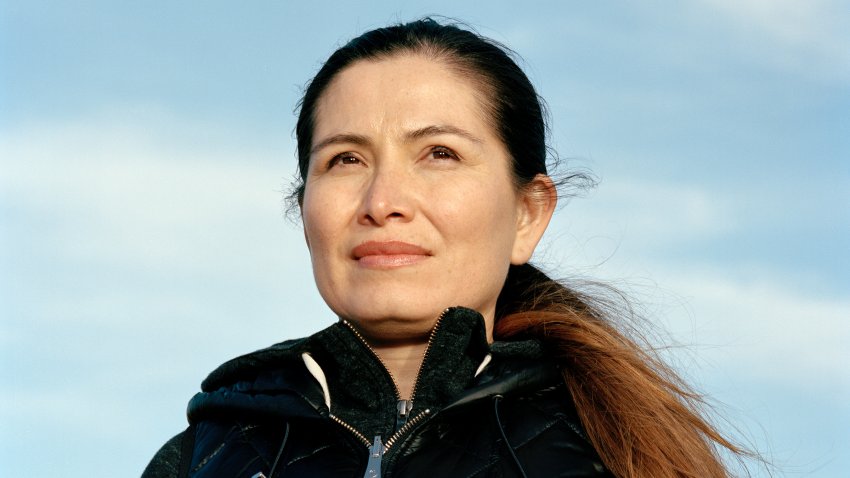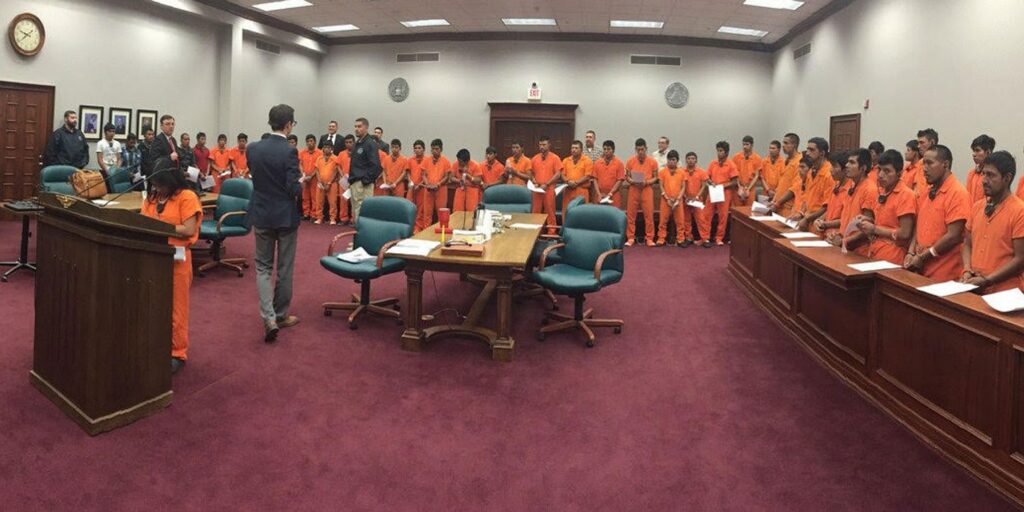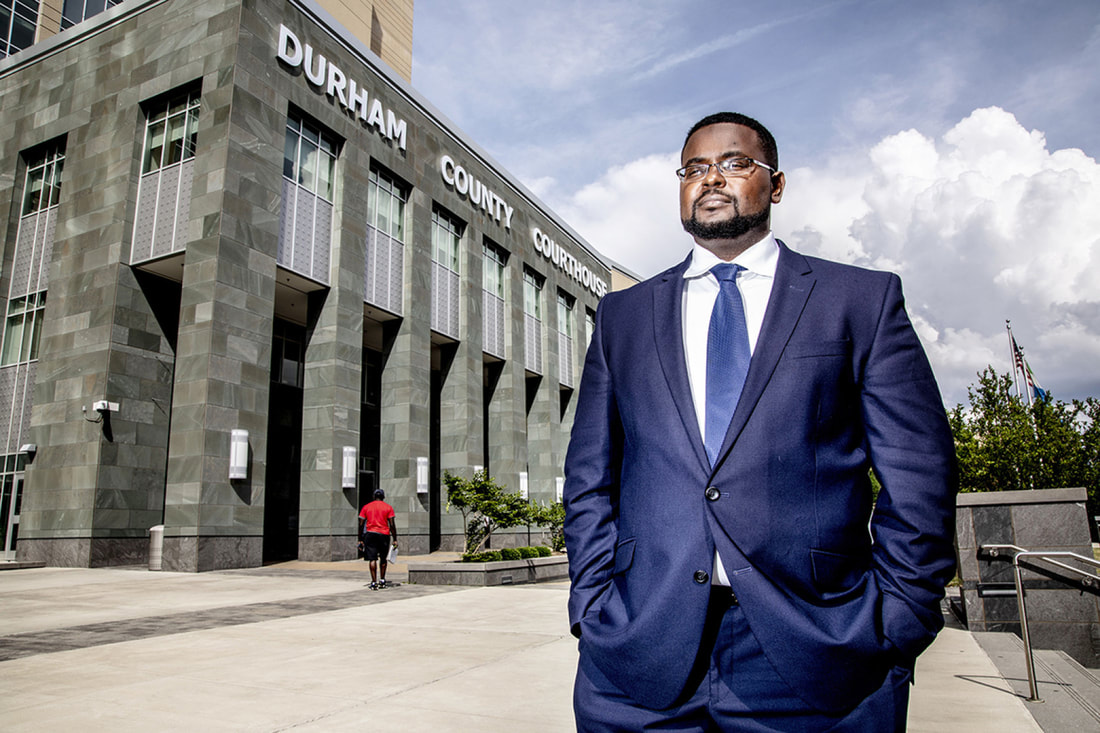#ChangeLawyer
On a chilly Wednesday morning in December, Jesse McCoy II headed upstairs to a third-floor courtroom full of cherrywood pews. The 34-year-old housing attorney had never before met his potential client and knew hardly any of the details of a case he might argue in less than 15 minutes.
Leona Roberts, a 42-year-old mother with a wide smile, was facing eviction from her $650-per-month yellow ranch in East Durham. The one-time nursing assistant always paid her rent, though sometimes it came with an extra $32 late fee. But a massive water and sewer bill of more than $700 in September forced her to choose between that and the rent. She chose the water bill, frustrated the landlord had ignored her complaints about leaking pipes. In late November, after Roberts complained to city inspectors about the pipes, the landlord filed to evict her.
“It does something to your soul, as a black attorney, when everyone at risk of losing their homes looks like you,” McCoy told me as he steered his baby blue Honda SUV past Durham’s apartment complexes. And he knows that most of the people facing eviction are already at a disadvantage because they don’t have legal representation. “They try to be honest: ‘Lost my job.’ ‘Got in a car accident.’ ‘Had an unexpected health crisis.’ You want to stand up to say: ‘These are not legal defenses.’”
McCoy and a skeleton crew of lawyers and law students—who prepare and argue cases under McCoy’s supervision—persuade landlords to accept payment plans with overdue tenants, sue over unsafe housing conditions, and in weaker cases simply help tenants buy more time to move out. Since last August, the diversion program has helped two-thirds of its clients stay in their homes and four out of five clients have kept the harmful mark of eviction off their records.
McCoy’s mother, a sharecropper’s daughter, often required her 8-year-old son to stay inside after school to read and discuss the works of black activists like George Jackson and Huey Newton and the author Ralph Ellison. Then came his run-in with the police. One day, an officer accused McCoy of throwing rocks into the street. McCoy, who was running an errand for his mother, had grocery bags in his hands. The officer placed him in a squad car, drove him past his town home complex, and let him out in sight of his mother. “I felt powerless,” McCoy said. “And I went from wanting to do science to wanting to be an attorney.”
In 2008, the year McCoy became a lawyer, the job market cratered. He knocked on the doors of Durham law firms, offering to work for free to gain experience. Eventually, he took on indigent clients in Raleigh who couldn’t be represented by the public defender’s office due to legal conflicts. Starting there, he built a solo practice over four years.
“I was a 25-year-old black male practicing law,” McCoy said. “The people who I represented looked like me. Once I handled someone’s case, they spread my name, they’d tell their friends and family.”
McCoy hopes to get public funding to support a goal of cutting evictions in half in Durham County. That would mean devoting more time to clients like Leona Roberts.
This spring, McCoy recently turned his attention toward Roberts’ counterclaim. McCoy argued a lack of repairs impaired Roberts’ “health, safety, and enjoyment of the premises,” and that the landlord’s behavior was “unethical, oppressive, unscrupulous, and substantially injurious.” He sought damages of nearly $5,000—$3,200 for a rent reimbursement, $677.95 for excess water bills, $1,000 in civil penalties—plus attorney’s fees. The landlord recently agreed to a settlement rather than take her chances in court.
Roberts currently rents a room in a rundown boarding house in south Durham. For $125 a week, she has just enough space for her bed, a small television, and a shelf for her belongings. “I’m making it work,” she said, sitting on her bed, one day after work cleaning one of UNC’s academic buildings in nearby Chapel Hill. “But it’s not part of my long-term plans.”
“To have someday to take the time [to help], I’m grateful,” she said. “He was a blessing in disguise.”
Story by Politico >
Meet the next generation of Native lawyers suing the federal government
#ChangeLawyer

Ethel Branch, attorney general for the Navajo Nation, sits on a leather couch in a Salt Lake City production studio, sipping bottled water and keeping a close eye on the television screen. It’s December 4, 2017. She’s been waiting for this day for eight months.
A few miles away, at the Utah State Capitol, the President of the United States stands at a podium beneath a mural that reads PEACE WITH THE INDIANS.
Branch’s face registers patient, precise focus. At 38, she oversees a Navajo Nation criminal-justice system that extends throughout Arizona, New Mexico, and Utah. Back in the nineties, when Trump was negotiating various bankruptcies, she was castrating horses and winning rodeo-queen contests on the reservation. She went on to graduate from Harvard Law School and the university’s Kennedy School of Government, and took over the tribe’s Department of Justice at 36.
Bears Ears, a landscape marked by two mesas climbing out of the Utah desert, geologic high marks overseeing a sacred region of canyons and cliff dwellings. In 2015, five tribes, some of which have long been at odds—notably the Hopi and the Navajo—formed the Bears Ears Intertribal Coalition, an effort to protect the area.
That work was rewarded in December 2016, when outgoing president Barack Obama created Bears Ears National Monument using the 1906 Antiquities Act.
But as soon as Trump took office, Utah’s Republican congressional delegation began to apply pressure, seeking to overturn the designation.
And it will soon fall to Branch and her legal colleagues to try and block his proclamation, to continue the centuries-old war for Native American rights while arguing the most consequential public-lands case in a generation, one that could determine the limits of presidential authority on much of America’s wild estate.
Natalie Landreth doesn’t listen to the speech. She knows what’s coming.
Landreth is 44, a star attorney for the Native American Rights Fund, a nonprofit group that represents the thorniest cases in Indian country. NARF was born of the civil rights movement, an organization created to defend those who had binding treaties but few lawyers to enforce them.
In short order, NARF turned the law into a weapon for Native Americans, using it to prevail over the states of Maine (in a precedent-setting case that upheld previously unrecognized tribes’ claims to land taken by the state) and Washington (in a seminal fishing-rights case).
NARF’s lawyers have been busy since Trump’s inauguration. “It’s like being in a fort under siege,” says Landreth, “and wondering, When are we going to get some water?”
Matthew Campbell, a 36-year-old member of Alaska’s Native Village of Gambell who grew up in suburban Denver and came to NARF in 2013 after following a winding path in his younger life. “I became interested in the law,” he says, “because I had run-ins with the law.”
“You have this identity issue,” says Campbell. “This living-in-two-worlds issue.” He is talking not just about himself but about his profession. For Native litigators, the job is not only to win. It’s to faithfully and sensitively convey a client’s worldview in a venue that’s often unfriendly to that perspective, to demand respect for that position so that the court elevates it.
Together, Campbell, Landreth, and Branch represent a new generation of legal advocates for Indian country. They came to the work from different places—suburban Denver, the consumer panoply of Orange County, California, and an Arizona ranch with no running water or electricity.
“It’s powerful to see young Native American attorneys defend the sovereign lifestyles of tribal people,” says Heather Kendall-Miller, a NARF attorney from Alaska and one of the handful of Native women to have argued in front of the Supreme Court.
How long all this will take is unknown. The fight is, in the words of John Leshy, a former solicitor at Interior, “a pretty straightforward kind of case” from a litigation point of view. But it’s hugely consequential, potentially dictating the stability of America’s 117 national monuments—and pitting an indigenous worldview against that of a real estate developer from Queens.
Story by Outside Magazine >
Lawyer explains how a 53 week old infant was separated from his mother at the border
Watch This
The truth about the 1500 missing migrant children
Top Tweet
The following Twitter thread was written by lawyer Josie Duffy Rice, a criminal justice reformer and senior strategist the Fair Punishment Project.
Now that we’re all on twitter because of this game, I am making a public service announcement: PLEASE STOP SHARING THAT STORY ABOUT 1500 KIDS MISSING. The outrage I’ve seen is a result of a total misinterpretation and could SERIOUSLY threaten the children you want to save.
— josie duffy rice (@jduffyrice) May 28, 2018
Transgender Law Center accuses ICE of deplorable conditions after transgender woman dies in their custody
Less of This

LGBT immigrant rights activists have called on the U.S. Immigration and Customs Enforcement (ICE) agency to stop holding detainees in “inhumane” conditions after a 33-year-old transgender woman who travelled to the U.S. with the so-called “refugee caravan” died in ICE’s custody.
LGBT immigrant rights advocates with the Transgender Law Center (TLC) said that while ICE has identified the woman as Jeffry Hernández, she had identified herself as Roxana Hernández.
ICE said she was pronounced dead on May 25 at 3:32 a.m., with medical center staff identifying her preliminary cause of death as cardiac arrest. She has been the sixth detainee to die in ICE custody in fiscal year 2018.
TLC said her death highlights the need for action in stopping ICE from holding “transgender immigrants in deplorable and inhumane detention conditions.”
“It has been repeatedly reported that asylum seekers at the border are held in freezing holding cells (often referred to as “hieleras”) for days,” TLC said, later suggesting that Hernandez’s symptoms of pneumonia could have been related to the conditions she was held in.
“Transgender immigrants often seek asylum, withholding of removal or protection under the Convention Against Torture because of violence, rape and torture they have experienced in their countries of origin due to their gender identity or expression,” TLC.
“However, once inside the United States, transgender immigrants may often face similar risks, as well as criminalization, as they are targeted and harassed by police or held in detention where they experience violence, discrimination, and an inability to access to medical care, all of which may lead to dire consequences,” the legal center added.
“Paired with the abuse we know transgender people regularly suffer in ICE detention, the death of Ms. Hernández sends the message that transgender people are disposable and do not deserve dignity, safety, or even life,” TLC Deputy Director Isa Noyola said in a statement.
Story by Newsweek >
A look at the “mass trials” where children are taken away from their parents
Less of This Too

Federal Magistrate Judge Ronald G. Morgan is in his 60s, with a bright-pink face and a crisp, friendly manner — though lately he has been making disconcerting little mistakes in court. He has spent eight years on the bench in Brownsville, a small Texas city on the U.S.-Mexico border. Morgan knows how to run a court smoothly, but during a morning session I attended in early May, he announced that he’d just dealt with 35 defendants — all at one time — when the actual number was 40. And after the proceedings, he forgot to pronounce their guilt. Marshals had already led them out, so Morgan sheepishly had to call the 40 defendants back to the courtroom to correct his error. These days, he seems distracted and troubled.
That is understandable. In late April, magistrates’ courts in Brownsville suddenly turned into “zero tolerance” factories for criminalizing migrants, many of whom have no prior criminal record. Many are from murderously violent countries in Central America and have fled to the U.S. seeking asylum, and they often arrive with children in tow. It used to be rare to charge migrants seeking asylum with crimes. If they did so, they were put into detention with their children while they pursued their claims. Or they were released with supervision — along with their children. The best interests of the children were considered paramount, and those interests including keeping families together.
The anguish that parents communicated in Morgan’s courtroom, and the spectacle of dozens of migrants being convicted and sentenced en masse, in proceedings lasting just a few minutes and with only the most perfunctory legal representation, has shocked courthouse employees.
But most Americans do not attend these courts. They live far from the border, and Sessions’s new “zero tolerance” plan seems distant and theoretical. On the border itself, however, the new policy feels close and horribly real. Sessions’s policy of deliberately breaking up families is a new low in U.S. border policy.
Each day was the same. The courtroom was filled with exhausted immigrants, with hands cuffed and shackled to their waists, their legs in chains — dozens of defendants stumbling, shuffling, clanking, and clanging in tandem.
A very small, very young woman with chiseled features and disheveled hair spoke. She had been apprehended two days earlier after rafting across the Rio Grande near a county park with big trees and picnic tables that abuts the international line. She wept as she told Morgan, “I’d like to apologize, but the circumstances in my country made me do it.” She said she’d been almost raped and killed there, and she had come to the U.S. for protection and to see if she could help her sisters escape the danger.
One woman who spoke about her children in open court was from Honduras. “Is my little girl going to go with me when I get deported?” she asked Morgan.
“Your Honor,” interjected Jeff Wilde, director of the Federal Public Defender’s office in Brownsville, “both she and the man next to her have their children with them. They had a credible fear claim [for asylum]. … Their children have been separated from them, and I’ve been unable to figure out where their children are at this point.”
The judge tried to assume his crisp air. But he seemed overwhelmed, with the parents’ worry and with suspicion that the government was misrepresenting to him what was really happening to the children.
Delia said she fled her country weeks ago and went on the road to Mexico, eventually crossing the Rio Grande with her child on an inner tube. She saw three Border Patrol agents watching her and floated in their direction, so she could turn herself in.
Delia said that when she arrived later that night at the hielera — the Border Patrol processing office — she told the officers that she and her child needed asylum. She described the beatings and assaults and death threats. “Oh, come on!” she said the officers snickered. “You and everyone else with that old story!”
“You’re going to be deported,” she remembers them telling her. “And your child will stay here.” The next morning, the child was taken. Delia fell on her knees during the removal, wailing and begging not to be separated. Officials looked on indifferently, she said, as her child screamed incessantly.
Story by the Intercept >









